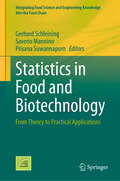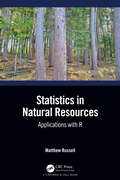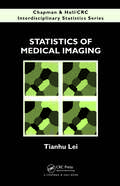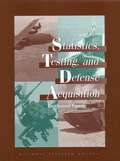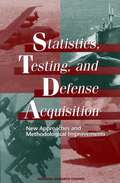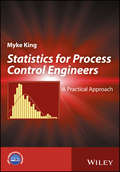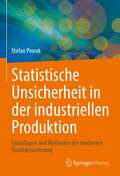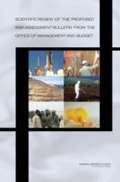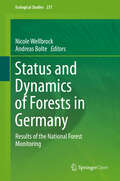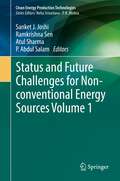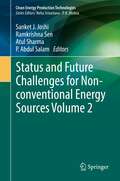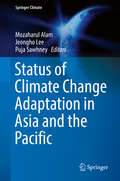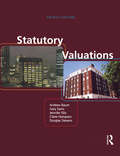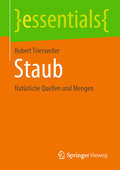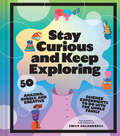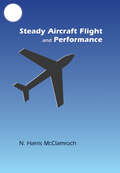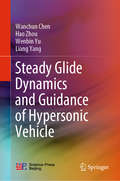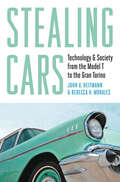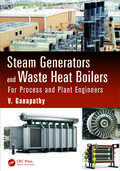- Table View
- List View
Statistics in Food and Biotechnology: From Theory to Practical Applications (Integrating Food Science and Engineering Knowledge Into the Food Chain #16)
by Saverio Mannino Gerhard Schleining Prisana SuwannapornThe proper use of statistical methods is essential in food processing and biotechnology, and very few publications have focused on the practical application of these methods. This book utilizes case studies to explain the corresponding basics with a focus on understanding how and when to use the appropriate statistical methods. The text is structured according to practical applications, starting from data collection and data treatment, moving to product development, process control and analytical methods. Practical Examples of Using Statistics in Food and Biotechnology begins with a detailed introduction to statistics and their use in food processing. The first main section focuses on statistics for data collection and treatment featuring scales of measurement, sampling and summarizing and presenting data. Another section looks at statistics for food product and process development, examining mixture experiments for different food groups from meat and fish to vegetables, juices, rice and olive oils. Further sections focus on statistical process control, statistics for sensory science and a wide range of analytical methods including LC-MS/MS and other cutting edge methods. In providing practical, hands-on information on the use of statistics in food processing, this work will be of major importance for food professionals, industry staff and researchers in food and biotechnology. .
Statistics in Natural Resources: Applications with R
by Matthew RussellTo manage our environment sustainably, professionals must understand the quality and quantity of our natural resources. Statistical analysis provides information that supports management decisions and is universally used across scientific disciplines. Statistics in Natural Resources: Applications with R focuses on the application of statistical analyses in the environmental, agricultural, and natural resources disciplines. This is a book well suited for current or aspiring natural resource professionals who are required to analyze data and perform statistical analyses in their daily work. More seasoned professionals who have previously had a course or two in statistics will also find the content familiar. This text can also serve as a bridge between professionals who understand statistics and want to learn how to perform analyses on natural resources data in R. The primary goal of this book is to learn and apply common statistical methods used in natural resources by using the R programming language. If you dedicate considerable time to this book, you will: Develop analytical and visualization skills for investigating the behavior of agricultural and natural resources data. Become competent in importing, analyzing, and visualizing complex data sets in the R environment. Recode, combine, and restructure data sets for statistical analysis and visualization. Appreciate probability concepts as they apply to environmental problems. Understand common distributions used in statistical applications and inference. Summarize data effectively and efficiently for reporting purposes. Learn the tasks required to perform a variety of statistical hypothesis tests and interpret their results. Understand which modeling frameworks are appropriate for your data and how to interpret predictions. Includes over 130 exercises in R, with solutions available on the book’s website.
Statistics of Medical Imaging (Chapman & Hall/CRC Interdisciplinary Statistics)
by Tianhu LeiStatistical investigation into technology not only provides a better understanding of the intrinsic features of the technology (analysis), but also leads to an improved design of the technology (synthesis). Physical principles and mathematical procedures of medical imaging technologies have been extensively studied during past decades. However, les
Statistics of Quality (Statistics: A Series Of Textbooks And Monographs #153)
by SUBIR GHOSH; WILLIAM R. SCHUCANY; WILLIAM B. SMITHExplains the role of statistics in improving the quality of collecting and analyzing information for a wide variety of applications. The book examines the function of statisticians in quality improvement. It discusses statistical process control, quality statistical tables, and quality and warranty; quality standards in medicine and public health; Taguchi robust designs and survival models; and more.
Statistics, Testing, and Defense Acquisition: Background Papers
by Michael L. Cohen Duane L. Steffey John E. RolphThe National Academies Press (NAP)--publisher for the National Academies--publishes more than 200 books a year offering the most authoritative views, definitive information, and groundbreaking recommendations on a wide range of topics in science, engineering, and health. Our books are unique in that they are authored by the nation's leading experts in every scientific field.
Statistics, Testing, and Defense Acquisition: New Approaches and Methodological Improvements
by Michael L. Cohen Duane L. Steffey John E. RolphFor every weapons system being developed, the U.S. Department of Defense (DOD) must make a critical decision: Should the system go forward to full-scale production? The answer to that question may involve not only tens of billions of dollars but also the nation's security and military capabilities. In the milestone process used by DOD to answer the basic acquisition question, one component near the end of the process is operational testing, to determine if a system meets the requirements for effectiveness and suitability in realistic battlefield settings. Problems discovered at this stage can cause significant production delays and can necessitate costly system redesign.This book examines the milestone process, as well as the DOD's entire approach to testing and evaluating defense systems. It brings to the topic of defense acquisition the application of scientific statistical principles and practices.
Statistics, Testing, and Defense Acquisition: New Approaches and Methodological Improvements
by Panel on Statistical Methods for Testing Evaluating Defense SystemsFor every weapons system being developed, the U.S. Department of Defense (DOD) must make a critical decision: Should the system go forward to full-scale production? The answer to that question may involve not only tens of billions of dollars but also the nation's security and military capabilities. In the milestone process used by DOD to answer the basic acquisition question, one component near the end of the process is operational testing, to determine if a system meets the requirements for effectiveness and suitability in realistic battlefield settings. Problems discovered at this stage can cause significant production delays and can necessitate costly system redesign.This book examines the milestone process, as well as the DOD's entire approach to testing and evaluating defense systems. It brings to the topic of defense acquisition the application of scientific statistical principles and practices.
Statistics: A Practical Approach for Process Control Engineers
by Myke KingThe first statistics guide focussing on practical application to process control design and maintenance Statistics for Process Control Engineers is the only guide to statistics written by and for process control professionals. It takes a wholly practical approach to the subject. Statistics are applied throughout the life of a process control scheme – from assessing its economic benefit, designing inferential properties, identifying dynamic models, monitoring performance and diagnosing faults. This book addresses all of these areas and more. The book begins with an overview of various statistical applications in the field of process control, followed by discussions of data characteristics, probability functions, data presentation, sample size, significance testing and commonly used mathematical functions. It then shows how to select and fit a distribution to data, before moving on to the application of regression analysis and data reconciliation. The book is extensively illustrated throughout with line drawings, tables and equations, and features numerous worked examples. In addition, two appendices include the data used in the examples and an exhaustive catalogue of statistical distributions. The data and a simple-to-use software tool are available for download. The reader can thus reproduce all of the examples and then extend the same statistical techniques to real problems. Takes a back-to-basics approach with a focus on techniques that have immediate, practical, problem-solving applications for practicing engineers, as well as engineering students Shows how to avoid the many common errors made by the industry in applying statistics to process control Describes not only the well-known statistical distributions but also demonstrates the advantages of applying the large number that are less well-known Inspires engineers to identify new applications of statistical techniques to the design and support of control schemes Provides a deeper understanding of services and products which control engineers are often tasked with assessing This book is a valuable professional resource for engineers working in the global process industry and engineering companies, as well as students of engineering. It will be of great interest to those in the oil and gas, chemical, pulp and paper, water purification, pharmaceuticals and power generation industries, as well as for design engineers, instrument engineers and process technical support.
Statistik
by Hans-Joachim MittagBeim Multimedia-Comenius-Wettbewerb 2011 ausgezeichnet, bietet das Lehrbuch als Kombination aus Druckwerk und interaktiver Online-Fassung eine gelungene Einführung in die Statistik. Das Anwendungsspektrum der Statistik wird anhand aktueller Beispiele illustriert, die statistischen Konzepte in Grafiken visualisiert. Der Band enthält viele Übungsaufgaben mit ausführlichen Lösungen. Die überarbeitete 2. Auflage wird durch neue interaktive Experimente und tongestützte Animationen ergänzt und bietet frei zugängliche Multimedia-Ressourcen im Internet.
Statistische Unsicherheit in der industriellen Produktion: Grundlagen und Methoden der modernen Qualitätssicherung
by Stefan ProrokDieses Buch stellt statistischen Verfahren und Kennzahlen vor, um Unsicherheiten in der industriellen Produktion zu analysieren und einzuschätzen. Der Autor legt hierbei einen besonderen Fokus auf die Fallstricke der einzelnen Verfahren. Für alle im Buch vorgestellten Verfahren werden neben den mathematischen Formeln auch Auswerteblätter und Nomogrammen vorgestellt. Auf diese Weise können Anwender im Problemfall eine schnelle Bewertung der Ausgangssituation vorzunehmen.Die vorgestellten Verfahren sollen den Leser in die Lage versetzen, die Hauptquellen für Unsicherheit in Prozessen zu ermitteln. Der Einsatz statistischer Verfahren zur Definition und Wirksamkeitsprüfung von Verbesserungsmaßnahmen ist ein Kernthema dieses Buches.Das Vorgehen wird anhand praktischer Beispiele und Handlungsempfehlungen dargelegt.
Status Of Pollinators In North America
by National Research Council of the National AcademiesPollinators&#8212insects, birds, bats, and other animals that carry pollen from the male to the female parts of flowers for plant reproduction&#8212are an essential part of natural and agricultural ecosystems throughout North America. For example, most fruit, vegetable, and seed crops and some crops that provide fiber, drugs, and fuel depend on animals for pollination. This book provides evidence for the decline of some pollinator species in North America, including America’s most important managed pollinator, the honeybee, as well as some butterflies, bats, and hummingbirds. For most managed and wild pollinator species, however, population trends have not been assessed because populations have not been monitored over time. In addition, for wild species with demonstrated declines, it is often difficult to determine the causes or consequences of their decline. This book outlines priorities for research and monitoring that are needed to improve information on the status of pollinators and establishes a framework for conservation and restoration of pollinator species and communities.
Status and Dynamics of Forests in Germany: Results of the National Forest Monitoring (Ecological Studies #237)
by Nicole Wellbrock Andreas BolteThis book is an open access publication.Forest ecosystems in Central Europe are changing as a result of anthropogenic influences and changing climate conditions. As such, a large-scale monitoring programme was undertaken in order to understand the influence of site modification, deposition of air pollutants, and climate. This book presents the scientific findings of this study for Germany, including the major challenges with regard to the future preservation and management of forest ecosystems under environmental change. In addition, it addresses a number of central questions: what are the main factors affecting forest stands and soil integrity? How, and how rapidly, are forest ecosystems changing? How diverse are the changes across Germany? What will be the main risks in sustainable forest management in the future? And how can policy support the development and maintenance of adaptive and resilient forests that provide essential ecosystem services, today and in the future? Helping readers understand the importance of soils and related ecosystem processes for future sustainable forestry, and sharing essential findings on environmental change and related changes in forest status and dynamics, the book is a valuable resource for researchers and policymakers interested in science-based decisions.
Status and Future Challenges for Non-conventional Energy Sources Volume 1 (Clean Energy Production Technologies)
by P. Abdul Salam Atul Sharma Ramkrishna Sen Sanket J. JoshiThis book highlights recent advancements in such an important topic, through contribution from experts demonstrating different applications in ‘day-to-day’ life, both existing and newly emerging non-biological technologies, and thought provoking approaches from different parts of the world, potential future prospects associated with some frontier development in non-conventional energy sources. It covers different types of natural energy sources such as: Ocean, Tidal and Wave energy; Nuclear energy; Solar cells; Geothermal energy; Hydrogen Fuel; Photovoltaic modules; Gas hydrates; Hydrate-based Desalination Technology; and Hydrothermal Liquefaction of Kraft Lignin/ Lignocellulosic Biomass to Fuels and Chemicals. This book is a comprehensive and informative compilation for international readers, especially undergraduate and post graduate students and researchers.
Status and Future Challenges for Non-conventional Energy Sources Volume 2 (Clean Energy Production Technologies)
by P. Abdul Salam Atul Sharma Ramkrishna Sen Sanket J. JoshiThis book highlights recent advancements in such an important topic, through contribution from experts demonstrating different applications in ‘day-to-day’ life, both existing and newly emerging biological technologies, and thought provoking approaches from different parts of the world, potential future prospects associated with some frontier development in non-conventional energy sources. It covers different aspects of cellulosic and lignocellulosic biomass; Cellulosics Biorefinery; Algal Biofuels; Biodiesel; Bioethanol; Microbial Fuel Cells; Biofuel cells; and biohydrogen production. This book is a comprehensive and informative compilation for international readers, especially undergraduate, post graduate students and researchers.
Status of Climate Change Adaptation in Asia and the Pacific (Springer Climate)
by Mozaharul Alam Jeongho Lee Puja SawhneyThis volume provides an overview of the climate change adaptation objectives set, actions taken, and challenges faced by several countries in the Asia-Pacific region. The majority of the populations in this region struggle to make a living from subsistence agriculture, and livelihoods are highly dependent on natural ecosystem services which are likely to be severely affected by climate change. Cases discussed in this book highlight successes made by governments towards achieving adaptation objectives, and efforts required to overcome challenges. While significant economic advances have been made, the pace of growth has been slow to impact the lives of a majority of the people who live below the poverty line. The chapters highlight adaptation actions for protecting people and their livelihoods in priority sectors, maintaining food and water security, supporting socio-economic stability including poverty reduction, and climate risk management. This book also maximizes readers' insights into the knowledge gaps and limitations of stated adaptation goals, and the bottlenecks that hinder implementation in different regions.
Statutory Valuations
by Jennifer Ellis Andrew Baum Gary Sams Claire Hampson Douglas StevensThe fourth edition of Statutory Valuations has been completely revised and expanded and draws on the expertise of several new authors. The text reflects the effect of the considerable statutory changes over the ten years since the last edition. There are new chapters dealing with taxation (income tax, corporation tax, capital gains tax, inheritance tax, stamp duty land tax and VAT) and with rating and council tax. As in previous editions, there is full coverage of the valuation implications of regulation of the landlord and tenant relationship in commercial property; the impact of both the Rent Acts and leasehold reform on residential property; as well as comprehensive material on the background to, and assessment of, compulsory purchase and planning compensation. This book is designed both for students and practitioners and is a must-buy for anyone seeking a comprehensive analysis of the law relating to valuation as well as practical approaches to dealing with valuation problems. The clear concise narrative provides worked examples of valuations.
Staub: Natürliche Quellen und Mengen (essentials)
by Robert TrierweilerDieses essential beinhaltet Informationen zu den natürlichen Staubquellen, den unterschiedlichen Entstehungsprozessen und den Mengen der natürlichen Staubemissionen. Die Bildungsmechanismen von Primärpartikeln und Sekundärpartikeln werden beschrieben und die wichtigsten Präkursoren werden genannt. Daneben werden Schätzwerte für die globalen Emissionswerte von Primärpartikeln und Sekundärpartikeln sowie von Präkursoren zusammengetragen.
Stay Curious and Keep Exploring: 50 Amazing, Bubbly, and Creative Science Experiments to Do with the Whole Family
by Emily CalandrelliFrom the host of Netflix's Emily's Wonder Lab and FOX's Xploration Outer Space comes a book featuring 50 experiments that introduce the wonders of science to the whole family. MIT engineer Emily Calandrelli shares the science behind each experiment while showing you where to find STEAM concepts in the world around you. You'll learn how to think like a scientist with Make a Hypothesis! and Try This! prompts, where you can experiment within the experiment. With Calandrelli's expert guidance, illustrations throughout, and easy-to-find grocery items, you can make: An alien hovercraft to learn how an air hockey table worksGlow in the dark paint to learn about ultraviolet lightDelicious ice cream to learn about supercoolingOobleck to learn why ketchup is so hard to get out of the bottle With chapters like Magic Tricks, Kitchen Science, and Fun with Physics, this book is packed with experiments that will delight little scientists and their lab assistants. Grab your goggles and a family member to get started on a journey to spark curiosity, critical thinking, and fun family times!
Staying Safe with Technology (Take Care of Yourself)
by Ashley RichardsonTechnology is all around us all the time. Readers will learn ways to stay safe while using technology and important steps to take if they run into problems.
Steady Aircraft Flight and Performance
by N. Harris McClamrochThis undergraduate textbook offers a unique introduction to steady flight and performance for fixed-wing aircraft from a twenty-first-century flight systems perspective. Emphasizing the interplay between mathematics and engineering, it fully explains the fundamentals of aircraft flight and develops the basic algebraic equations needed to obtain the conditions for gliding flight, level flight, climbing and descending flight, and turning flight. It covers every aspect of flight performance, including maximum and minimum air speed, maximum climb rate, minimum turn radius, flight ceiling, maximum range, and maximum endurance. Steady Aircraft Flight and Performance features in-depth case studies of an executive jet and a general aviation propeller-driven aircraft, and uses MATLAB to compute and illustrate numerous flight performance measures and flight envelopes for each. Requiring only sophomore-level calculus and physics, it also includes a section on translational flight dynamics that makes a clear connection between steady flight and flight dynamics, thereby providing a bridge to further study. Offers the best introduction to steady aircraft flight and performance Provides a comprehensive treatment of the full range of steady flight conditions Covers steady flight performance and flight envelopes, including maximum and minimum air speed, maximum climb rate, minimum turn radius, and flight ceiling Uses mathematics and engineering to explain aircraft flight Features case studies of actual aircraft, illustrated using MATLAB Seamlessly bridges steady flight and translational flight dynamics
Steady Glide Dynamics and Guidance of Hypersonic Vehicle
by Liang Yang Hao Zhou Wanchun Chen Wenbin YuThis book presents the latest researches on hypersonic steady glide dynamics and guidance, including the concept of steady glide reentry trajectory and the stability of its regular perturbation solutions, trajectory damping control technique for hypersonic glide reentry, singular perturbation guidance of hypersonic glide reentry, trajectory optimization based on steady glide, linear pseudospectral generalized nominal effort miss distance guidance, analytical entry guidance and trajectory-shaping guidance with final speed and load factor constraints. They can be used to solve many new difficult problems in entry guidance. And many practical engineering cases are provided for the readers for better understanding. Researchers and students in the fields of flight vehicle design or flight dynamics, guidance and control could use the book as valuable reference.
Stealing Air
by Trent ReedyYou can't just ask for the chance to fly . . .When his dad announced they were moving to Iowa, Brian looked forward to making some new friends. But on his first day there he makes an enemy instead -- Frankie Heller, the meanest kid in town. Brian needs to hang out with someone cool to get back on track. . . .Alex has always been the coolest guy around, and good with money, just like his dad. But now the family is struggling, and he needs to make some cash to keep up appearances. Then an opportunity falls in his lap . . . .Max is a scientific genius, but his parents are always busy with their own work. Building an actual plane should get their attention -- if only he wasn't scared of heights . . . The answer to all three boys' problems starts with Max's secret flyer. But Frankie and the laws of popularity and physics stand in their way. Can they work together in time to get their plan AND their plane off the ground?
Stealing Cars: Technology and Society from the Model T to the Gran Torino
by John A. Heitmann Rebecca H. MoralesThe technology-thwarting car thief has become as advanced as the cars themselves.As early as 1910 Americans recognized that cars were easy to steal and, once stolen, hard to find, especially since cars looked much alike. Model styles and colors eventually changed, but so did the means of making a stolen car disappear. Though changing license plates and serial numbers remain basic procedure, thieves have created highly sophisticated networks to disassemble stolen vehicles, distribute the parts, and/or ship the altered cars out of the country. Stealing cars has become as technologically advanced as the cars themselves. John A. Heitmann and Rebecca H. Morales’s study of automobile theft and culture examines a wide range of related topics that includes motives and methods, technological deterrents, place and space, institutional responses, international borders, and cultural reflections. Only recently have scholars begun to move their focus away from the creators and manufacturers of the automobile to its users. Stealing Cars illustrates the power of this approach, as it aims at developing a better understanding of the place of the automobile in the broad texture of American life. There are many who are fascinated by aspects of automobile history, but many more readers enjoy the topic of crime—motives, methods, escaping capture, and of course solving the crime and bringing criminals to justice. Stealing Cars brings together expertise from the history of technology and cultural history as well as city planning and transborder studies to produce a compelling and detailed work that raises questions concerning American priorities and values. Drawing on sources that include interviews, government documents, patents, sociological and psychological studies, magazines, monographs, scholarly periodicals, film, fiction, and digital gaming, Heitmann and Morales tell a story that highlights both human creativity and some of the paradoxes of American life.
Stealing Time: A Jonah Wiley Adventure
by Anne DublinThrown back in time by a mysterious pocket watch, Jonah and his stepbrother, Toby, are forced to overcome their differences and work together to return to the present. Jonah Wiley is having a tough time. First, his parents divorced, and now his mom is going to a conference and leaving him with his dad and stepmother. But after Jonah steals an antique pocket watch, he and his stepbrother Toby are hurled back in time — to Egypt, China, France, and other places around the world. In order to save themselves and get back to the present, Jonah and Toby must overcome their personal issues and work together to solve the tough problems they encounter.
Steam Generators and Waste Heat Boilers: For Process and Plant Engineers (Mechanical Engineering)
by V. GanapathyIncorporates Worked-Out Real-World ProblemsSteam Generators and Waste Heat Boilers: For Process and Plant Engineers focuses on the thermal design and performance aspects of steam generators, HRSGs and fire tube, water tube waste heat boilers including air heaters, and condensing economizers. Over 120 real-life problems are fully worked out which wi
